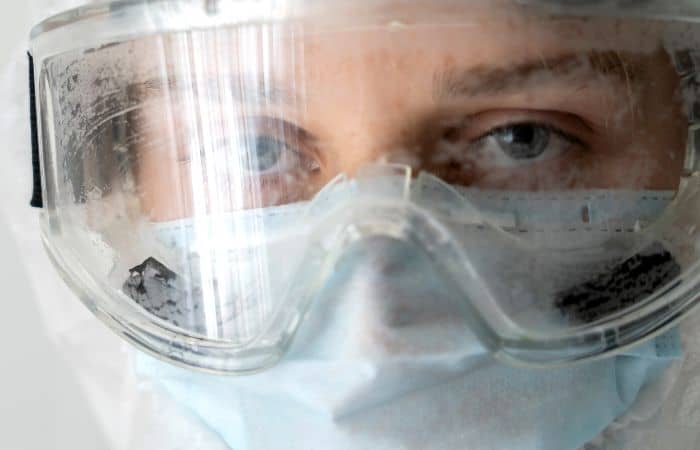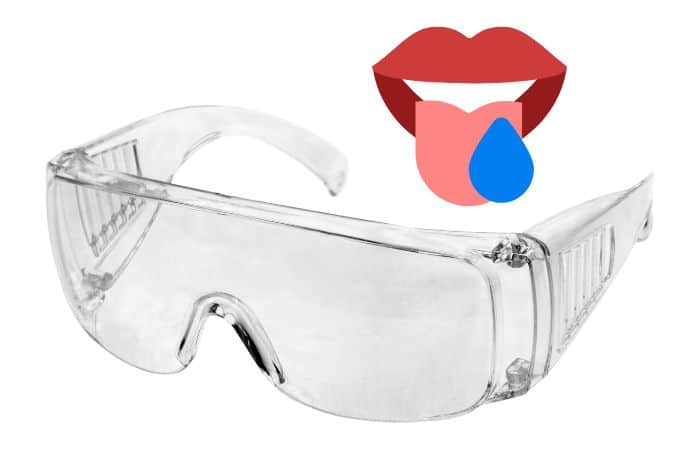If you wear safety glasses, you know that keeping them from fogging up can be a real pain. This can lead to not wearing them because you can’t see well, which puts you at risk for injury.
So how can you keep foggy lenses clear and dry? Here are a few tips to keep your safety glasses from fogging up so you can stay safe and avoid accidents.
(This page contains affiliate links. OGR may receive compensation if you click a link and make a purchase.)
What Causes Fog In Safety Glasses?

Fog occurs when the temperature of your lenses is different than the surrounding air. This can happen when you step outside on a cold day or when you’re working hard and sweating.
Workers who routinely go between indoor and outdoor environments, such as construction and warehouse workers, or first responders, are particularly susceptible to this problem.
Fog can also happen if you’re wearing a facemask and your breath wafts upwards and hits your lenses. Even the warmth emitted by your face in contrast to cooler surrounding air can cause fogging.
Additionally, poor airflow and/or dirty lenses can contribute to the problem. Older, worn-out safety glasses or goggles are also more likely to fog-up than newer ones.
Ways To Prevent Safety Glasses from Fogging Up
Use Anti-Fog Wipes, Spray, or Cloth
A simple way to defog lenses is to wipe them down with an anti-fog solution or wipe.
Spray the solution directly onto both sides of your lenses and spread it around evenly with your fingers. Then, use a clean microfiber cloth (often included with purchase of the spray) to wipe away any excess solution.
You can also find pre-moistened anti-fog wipes that work in the same way. Many of these come in individual packets that you can keep in your pocket for easy access.
There are even anti-fog microfiber cloths that work to prevent fogging without any sprays.
Another option is to apply an anti-fog treatment to your lenses before you put on your safety glasses. There are several different kinds of anti-fog treatments available, such as gels, liquids, and pastes.
You may need to try a couple of different products to find one that works well for you as anti-fog treatments tend to be somewhat hit-or-miss.
Dab Liquid Soap or Shaving Foam
Don’t have anti-fog spray or wipes on hand? Try using a small amount of liquid soap or shaving foam instead.
Apply a very small amount to your lenses and spread it around with your fingers. Then, lightly rinse the soap or shaving cream off with water and let them air dry. Don’t rinse too thoroughly because the point is to keep a thin layer of film on your lenses to prevent water droplets from adhering to them.
This little trick works wonders for swim goggles and scuba/snorkel masks too. Lots of scuba divers use baby shampoo instead of anti-fog in their masks before a dive.
Use Saliva

That’s right, ladies and gentlemen, if you have none of the above on you, your best bet may be to spit on your lenses and spread your saliva around.
The reason this works is that saliva acts as a surfactant, which means it lowers the surface tension of water. This prevents water droplets from adhering to your lenses and fogging up your vision.
Just make sure you don’t have any food or drink in your mouth when you do this as you don’t want to get anything on your lenses other than saliva.
We know, it’s not the most sanitary option, but it does work in a pinch. Be sure to clean your safety glasses thoroughly as soon as you can after your shift (which you should be doing anyway!).
Don’t Overdress

Since the warm temperature of your skin contributes to fogging, one way to help prevent it is to not overdress.
Wearing too many layers can trap heat and cause you to sweat, which will add moisture to the air and make it more likely for your lenses to fog up.
Don’t wear turtlenecks, thick sweaters, or other clothing that will trap heat and moisture next to your skin.
If you’re working in a cold environment, dress in layers so you can easily remove a layer if you start to feel too warm. It’s also a good idea to take breaks whenever you can to give your body a chance to cool down.
If you’re wearing a facemask, make sure it fits snugly against your face so your breath doesn’t escape and hit your lenses.
Drinking plenty of fluids helps keep your body temperature down too, so stay hydrated.
Keep Your Lenses Clean
One of the most important ways to avoid fogged lenses is to keep them clean. That means washing them with soap and water regularly, as well as wiping them down with a microfiber or lint-free soft cloth after every use.
You might be surprised to learn that dirt, dust, and even your own skin oils can contribute to foggy lenses. That’s because moisture has to attach to something, and dirty lenses provide the perfect surface.
When your lenses are clean, there’s nothing for moisture to cling to, so it will just roll right off.
So it’s important to keep them clean to prevent the build-up of these substances.
You should also avoid touching your lenses with your fingers as much as possible because the natural oils on your skin can leave behind a film that attracts dirt and dust.
Adjust Fit For Better Airflow

If you were given safety glasses by your employer, it may not always fit perfectly. An ill-fitting pair of safety glasses is more likely to fog-up than a pair that fits well, particularly if it doesn’t allow for good airflow between your face and the lenses.
Ensuring there’s sufficient space between your face and lenses allows for proper airflow and better equalization of temperatures on both sides of the lenses.
One way to improve the fit is to adjust the nose pads so they sit comfortably on your nose without slipping. Some safety glasses also come with an adjustable temple length, which can help you get a better fit.
If you use a strap, make sure it’s not too tight so that there’s some ventilation on the inside of your glasses.
Invest in Anti-Fog Safety Glasses/Lenses
If, after trying all of the above, you still find yourself constantly struggling with fogged lenses, it might be time to invest in a pair of fog-proof safety glasses or getting replacement lenses with an anti-fog coating. While not always perfect, they should help reduce the amount of fogging you experience.
Also if possible, choose a pair that has ventilated frames and lenses. This will help promote airflow so that moisture doesn’t accumulate inside your glasses.
Final Thoughts
Fogged-up lenses are not only annoying but can also be dangerous if you can’t see properly. By following the tips above, you should be able to reduce the amount of fogging you experience and stay safe while working.
If you have any other tips for preventing fogged safety glasses, please share!
